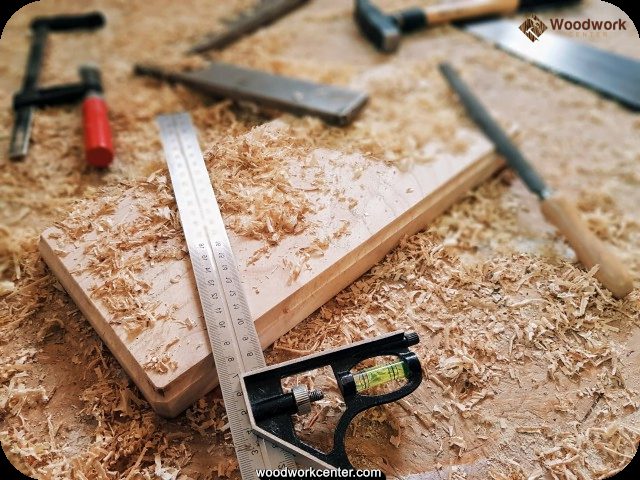Woodworking plans are an essential part of any successful woodworking project. Whether you are a beginner or an experienced woodworker, drafting accurate and detailed plans is crucial to ensure that your project turns out exactly as envisioned. In this section, we will explore the importance of having well-drafted woodworking plans, how they can save you time, money, and materials, and address common misconceptions about these plans.
Having well-drafted woodworking plans is the foundation of a successful project. It provides you with a clear roadmap to follow and helps you avoid costly mistakes. Accurate plans eliminate guesswork and uncertainty, allowing you to work efficiently and effectively. They serve as a blueprint for your project, outlining each step and providing precise measurements and dimensions.
One common misconception about woodworking plans is that they limit creativity or restrict individuality in craftsmanship. However, the truth is that well-drafted plans provide structure while still leaving room for personalization and creativity. They help bring your ideas to life while ensuring that your project meets functional requirements and maintains its visual appeal.
By understanding the importance of drafting woodworking plans early on in your woodworking journey, you set yourself up for success. In the following sections, we will delve into the tools needed for drafting these plans, the concept of scale and measurements involved, as well as step-by-step processes to help you create accurate and detailed plans for any woodworking project.
The Basic Tools Needed for Drafting Woodworking Plans
Drafting woodworking plans requires a specific set of tools to ensure accuracy and precision. These tools are essential in creating detailed and well-defined drawings that serve as blueprints for your woodworking projects. Here is an overview of the basic tools needed for drafting woodworking plans:
- Drawing Board: A drawing board provides a flat and stable surface to work on. It should have parallel edges for precise alignment of drawings. A good quality drawing board is recommended to prevent warping or bending.
- Drafting Pencils: Pencils with different lead hardness, such as H, HB, and B, are necessary for sketching and drawing lines with varying thicknesses. Harder leads (H) are ideal for fine details, while softer leads (B) create bolder lines.
- Drafting Straightedge: A straightedge is used to draw straight lines and guide measurements. It is typically made of transparent material like acrylic or aluminum, allowing you to see the underlying drawing.
- Compass: A compass is essential for drawing circles and arcs of various sizes. It consists of two arms connected by a center point, which can be adjusted to the desired radius.
- Triangles: Triangles with different angles (typically 30-60-90 degrees and 45-45-90 degrees) are used to draw accurate perpendicular lines and angles.
- Scale Ruler: A scale ruler helps you accurately measure and scale your drawings. It features multiple scales on both sides, enabling precise measurements at different scales depending on the size of your project.
- Erasers: Erasers are crucial for correcting mistakes or smudges on your drawings without damaging the paper or leaving marks behind.
While investing in high-quality drafting tools ensures better precision and durability, there are also affordable alternatives available for those on a budget. For instance, instead of purchasing a separate adjustable drawing board, you can use a sturdy table with a smooth surface and secure your papers with drafting tape or clips. Additionally, using a clear plastic sheet as a makeshift straightedge or triangle can suffice for beginners who are just starting out.
Having the right tools and equipment is essential in achieving accurate and detailed woodworking plans. By investing in quality tools and familiarizing yourself with their usage, you’ll be able to create well-crafted plans that will serve as guides for your woodworking projects.
Understanding Scale and Measurements in Woodworking Plans
In the world of woodworking, accuracy is key when it comes to creating successful projects. One crucial aspect of achieving this accuracy is understanding scale and measurements in woodworking plans. This section will delve into the concept of scale and proportion, the different measurement systems used in drafting plans, as well as provide some tips for accurate measurement and scaling techniques.
Explaining the Concept of Scale and Proportion
When it comes to woodworking plans, scale refers to the ratio between the dimensions on a drawing or model and their corresponding dimensions in real life. It determines how accurately a project will turn out when built. Proportion, on the other hand, refers to the size relationships between different parts of a project. Understanding both scale and proportion is essential for creating visually appealing and functional woodworking projects.
To effectively work with scale, woodworkers often use scaled drawings or models to represent their projects before they are built. This allows them to visualize how all the pieces fit together and make any necessary adjustments before cutting into costly materials. By having a clear understanding of how scaling works, woodworkers can ensure that their projects will be proportional and aesthetically pleasing.
Different Measurement Systems Used in Drafting Plans
Woodworking plans are typically drafted using either imperial (inch-based) or metric (centimeter-based) units of measurement. The choice between these two systems largely depends on personal preference or regional conventions. Some woodworkers may find one system more intuitive than the other based on where they live or their past experience.
Regardless of which measurement system you choose, consistency is key throughout your woodworking project. Mixing measurements from different systems can lead to errors and confusion during construction. When drafting your plans, be sure to clearly denote which unit of measurement you are using to avoid any potential issues down the line.
Tips for Accurate Measurement and Scaling Techniques
To ensure accuracy in your woodworking plans, it is crucial to develop good measurement and scaling techniques. Here are some tips to help you achieve this:
- Use reliable and precise measuring tools: Invest in high-quality measuring tools such as a tape measure, combination square, calipers, and rulers. These tools will provide accurate measurements and help you maintain consistency throughout your project.
- Take multiple measurements: To reduce the margin of error, take multiple measurements of the same dimension and average them. This helps to eliminate any minor discrepancies that may occur due to human error or tool variations.
- Double-check your calculations: When working with complex dimensions or scaling factors, double-check your calculations before finalizing your woodworking plans. A simple mistake can lead to significant errors when building the project.
- Practice scaling exercises: To improve your scaling skills, practice creating scaled drawings or models of existing objects. This will help you develop an eye for proportion and aid in visualizing how different elements will fit together in your projects.
By understanding scale and measurements in woodworking plans, you will be better equipped to create accurate and visually pleasing projects with confidence. Remember to select the appropriate measurement system for your needs and employ accurate measurement techniques throughout the drafting process. With practice and attention to detail, you can refine your skills and create woodworking plans that set you up for success in every project you undertake.
Step-by-Step Process of Drafting Woodworking Plans
The process of drafting woodworking plans requires careful consideration and attention to detail. By following a step-by-step approach, you can create accurate and comprehensive plans that will guide your woodworking projects. This section will outline the key steps involved in drafting woodworking plans, from initial concept to final details.
- Starting with a rough sketch or concept: Begin by visualizing your project and sketching out a rough idea of what you want to build. This will help you get a sense of the overall design and layout.
- Defining dimensions and drawing the basic shape: Once you have a rough concept, it’s time to define the dimensions and draw the basic shape of your project. Use a ruler or measuring tape to determine precise measurements, and use drafting tools like T-squares and triangles to create straight lines and angles.
- Including necessary details, joinery, and materials: As you refine your plans, be sure to include all necessary details such as joinery techniques, hardware requirements, and materials list. Pay close attention to any critical measurements or angles that need to be accurately represented in the plans.
| Step | Description |
|---|---|
| Step 1 | Start with a rough sketch of the bookshelf concept. |
| Step 2 | Measure the desired height, width, and depth of the bookshelf. |
| Step 3 | Use a T-square and ruler to draw straight lines representing the sides, shelves, and back panel. |
| Step 4 | Add details such as dado joints for the shelves, hardware locations, and any decorative elements. |
| Step 5 | Create a materials list specifying the type and quantity of wood needed. |
By following this step-by-step process, you can ensure that your woodworking plans are comprehensive, accurate, and easy to follow. Remember to take your time and double-check your measurements and details before finalizing your plans. With practice, you will become more efficient in drafting woodworking plans and be well-prepared for successful woodworking projects.
Utilizing CAD Software for Woodworking Plan Drafting
Woodworking plan drafting has evolved significantly with the advancement of technology. One of the most efficient and precise tools available to woodworkers is Computer-Aided Design (CAD) software. CAD software allows woodworkers to create detailed and accurate woodworking plans with ease. In this section, we will introduce you to CAD software and discuss popular options that are widely used in the woodworking community.
CAD software offers numerous advantages for woodworking plan drafting. One of the key benefits is precision. With CAD software, measurements can be entered directly into the program, eliminating the chances of human error. The software also allows for easy manipulation of dimensions and proportions, making it highly customizable and adaptable to various woodworking projects.
When it comes to choosing a CAD software for woodworking plan drafting, there are several options available.
- AutoCAD: AutoCAD is one of the most widely used CAD programs in the industry. It offers comprehensive drawing tools and features that allow woodworkers to create highly detailed plans.
- SketchUp: SketchUp is a user-friendly CAD program that is popular among beginners and hobbyist woodworkers. It has a simple interface and comes with pre-loaded 3D models that can be easily incorporated into your plans.
- Fusion 360: Fusion 360 is a powerful CAD software that combines both 2D and 3D functionalities. It offers advanced modeling tools and collaborative features that make it ideal for professional woodworkers working on complex projects.
While these CAD programs may require an initial investment, they prove to be valuable assets in saving time, increasing accuracy, and enhancing productivity in woodworking plan drafting.
Design Considerations and Incorporating Creativity in Woodworking Plans
When it comes to woodworking plans, design considerations play a crucial role in creating projects that are not only functional but also visually appealing. Balancing aesthetics and functionality is essential for achieving successful outcomes. This section will explore the importance of design considerations and provide guidance on incorporating creativity into your woodworking plans.
Balancing aesthetics and functionality in plan design
One of the key aspects of creating woodworking plans is finding the right balance between aesthetics and functionality. While functionality ensures that the project serves its intended purpose, aesthetics elevate the project into a work of art.
Whether you’re designing a piece of furniture or a decorative item, it’s important to consider how it will be used, where it will be placed, and who will be using it. Taking into account these factors will help guide your decisions on form, size, and materials.
Considerations for the specific woodworking project
Each woodworking project comes with its own set of considerations that need to be addressed during the planning phase. For example, if you’re building a chair, you’ll need to consider ergonomics to ensure comfort. If you’re constructing a shelf, you’ll need to think about weight-bearing capacity. Understanding the unique requirements of each project will help you make informed decisions when drafting your plans.
Additionally, consider how your woodworking project fits into its surroundings. Will it complement existing furniture or decor? Is there a specific style or theme you want to adhere to? These questions can guide your choices regarding design elements such as shape, color, texture, and finishes.
Incorporating personalized touches to make plans unique
Woodworking provides an opportunity for personal expression and creativity. Don’t be afraid to infuse your personality into your plans by adding personalized touches. This could include incorporating unique joinery techniques, carving intricate designs, or using contrasting wood species to create visual interest.
Moreover, consider who the project is intended for and tailor your design accordingly. If it is a gift for someone with specific interests or preferences, incorporate elements that reflect their personality. Adding these personal touches not only makes the project more meaningful but also showcases your skills and creativity as a woodworker.
By considering design factors, project-specific requirements, and adding personalized touches, you can elevate your woodworking plans from merely functional to truly exceptional. The next section will discuss how to effectively organize and document your plans for easy understanding and replication.
Organizing and Documenting your Woodworking Plans
When it comes to woodworking plans, organization and documentation are key. By creating clear and easy-to-follow instructions, you ensure that your plans can be understood by others and executed accurately. This section will guide you on how to effectively organize and document your woodworking plans.
Creating Clear Instructions
One of the first steps in organizing your woodworking plans is to create clear instructions that are easy to follow. This involves breaking down each step of the project into concise and understandable language. Consider using bullet points or numbered lists to outline the steps, providing clarity and making it easier for others to follow along.
Tips for Creating Clear Instructions
- Use simple language: Avoid using technical jargon or complex terms that may confuse readers.
- Include action verbs: Begin each instruction with an action verb to clearly communicate what needs to be done.
- Be specific: Provide detailed explanations of each step, including measurements, angles, and any other necessary information.
- Consider visual aids: Including diagrams or images can help clarify instructions, especially for complex processes.
Labeling and Annotating Drawings
In addition to clear instructions, labeling and annotating drawings is crucial for ensuring clarity in your woodworking plans. Labeling allows you to identify different parts or sections within a drawing, while annotations provide additional information or clarifications.
- Labeling: Each component of your woodworking project should be labeled with a corresponding number or letter. This helps readers understand the relationship between different parts of the project.
- Annotating: Annotations are used to provide additional information about specific details within a drawing. This could include dimensions, material specifications, or notes about assembly.
Consider using callout boxes or arrows to draw attention to important details in your drawings. This ensures that readers can easily identify and understand key aspects of the project.
Consistently Documenting Changes and Revisions
Throughout the woodworking process, it is common for plans to undergo changes or revisions. It is important to consistently document these changes to ensure that everyone involved is working with the most up-to-date version of the plans.
- Date and Version: Every time you make a change to your plans, clearly indicate the date and version number. This helps prevent confusion and ensures that everyone knows which version they are referring to.
- Edit Log: Keep a log of all your revisions, including details of what was changed and why. This serves as a reference for future adjustments or troubleshooting.
- Archiving: Make sure to save copies of each version of your woodworking plans, even after completion. This allows you to refer back to previous iterations if needed, and can serve as a reference for future projects.
By being diligent in organizing and documenting your woodworking plans, you not only improve communication with others but also establish good habits for yourself. These practices enhance efficiency, accuracy, and overall success in your woodworking endeavors.
Testing and Refining your Woodworking Plans
Drafting woodworking plans is an essential step in the woodworking process. Once you have completed a set of plans, the next crucial step is to test and refine them. This section will guide you through the necessary steps to ensure the feasibility and functionality of your plans.
The first step in testing your woodworking plans is building a prototype. A prototype allows you to see your design come to life and identify any practical challenges or design flaws. It gives you an opportunity to evaluate how well parts fit together, how stable the structure is, and whether it functions as intended.
Building a prototype also helps determine if the materials specified in your plans are suitable for the project. Making adjustments and refinements during this stage will save you time, money, and frustration later on.
In addition to building a prototype, seeking feedback from other woodworkers or professionals can provide valuable insights into improving your designs. They may uncover potential issues that you overlooked or offer suggestions for enhancing certain aspects of your plan. Constructive criticism is an important part of the refinement process and helps ensure that your final design meets high standards.
Once you have received feedback, it’s time to iterate and refine your woodworking plans accordingly. Make necessary revisions based on the feedback received, addressing any identified weaknesses or areas for improvement. Document these changes meticulously so that you can refer back to them if needed.
Testing and refining woodworking plans can be a lengthy process, but taking the time to do it properly will result in stronger designs and better outcomes for your projects. By building prototypes, seeking feedback, and making necessary refinements along the way, you will create woodworking plans that are not only accurate but also practical and functional for others who may want to use them in their own projects.
Conclusion
In conclusion, mastering the skill of drafting woodworking plans is crucial for any woodworker. Well-drafted plans not only save time, money, and materials but also ensure precision and efficiency in your projects. By understanding the importance of accurate plans and debunking common misconceptions, you have taken the first step towards becoming a skilled plan drafter.
Throughout this article, we have discussed the basic tools needed for drafting woodworking plans and the significance of using quality tools for precision. We have also explored the concept of scale and measurements in woodworking plans, providing tips for accurate measurement techniques. Additionally, we have covered the step-by-step process of drafting plans, including sketching rough concepts and adding necessary details.
Furthermore, we have touched upon utilizing CAD software as a tool for precision and efficiency in plan drafting. We have discussed popular CAD software options for woodworking plans and highlighted their advantages. Balancing aesthetics with functionality has been emphasized as an important consideration in plan design, along with incorporating personalized touches to make your plans unique.
To continue your journey towards mastery in drafting woodworking plans, it is essential to organize and document your plans clearly. Creating easy-to-follow instructions, labeling drawings, and documenting changes are key elements in producing professional-quality plans. Testing your plans through building prototypes and seeking feedback from fellow woodworkers or professionals will help refine your designs further.
Frequently Asked Questions
Can I sell woodworking plans?
Yes, you can definitely sell woodworking plans. With the growing popularity of DIY projects and woodworking as a hobby, there is a market for well-designed and detailed woodworking plans.
Many people are eager to learn new techniques and build their own furniture or other wooden items, but may not have the skills or knowledge to create their own plans. By offering high-quality woodworking plans for sale, you can provide value to these individuals and potentially make a profit.
Is SketchUp good for woodworking?
SketchUp can be an excellent tool for woodworking. SketchUp is a 3D modeling software that allows you to create detailed virtual representations of your woodworking projects. It provides a user-friendly interface with various tools that enable you to design and visualize your ideas easily.
This can be especially helpful in planning out dimensions, making accurate measurements, and anticipating any potential challenges before starting the actual woodworking process. Additionally, SketchUp offers numerous resources and tutorials specifically tailored for woodworkers, making it even more advantageous for those in the woodworking field.
How do I get into woodworking with no space?
If you don’t have much space available but still want to get into woodworking, there are several options you can consider. First, you could look into setting up a small workbench or table in an unused corner of your house or apartment. Utilizing portable tools or investing in compact power tools can also help maximize limited space while still allowing you to pursue woodworking projects.
Another option is joining a local makerspace or community workshop that provides access to shared tools and workspace for a membership fee. These spaces often have all the necessary equipment and offer the advantage of learning from experienced woodworkers who share the same passion as you do. Lastly, if both these options are not viable for you, consider taking advantage of outdoor spaces such as garages or patios during favorable weather conditions when working on larger projects that require more room.

Hi everyone! I’m a woodworker and blogger, and this is my woodworking blog. In my blog, I share tips and tricks for woodworkers of all skill levels, as well as project ideas that you can try yourself.





